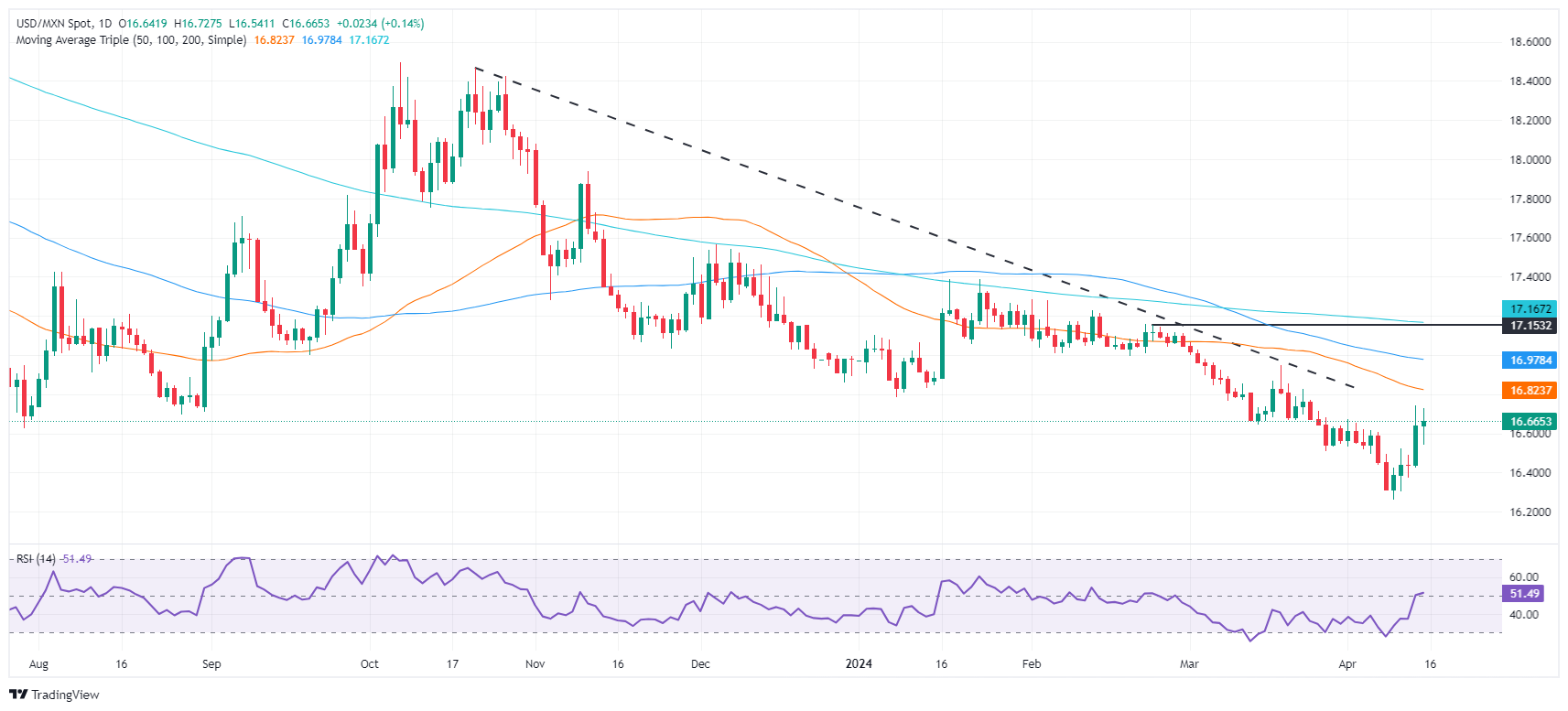Mexican Peso weakens on strong US Retail Sales, high US yields
- Mexican Peso falls against strengthening US Dollar, driven by unexpectedly robust US Retail Sales for March.
- Mexico’s absence of significant data leaves USD/MXN pair more responsive to US economic data, risk appetite.
- Forecasts for US economic growth look promising, Atlanta GDP Now predicting 2.4% growth rate in Q1 2024.
The Mexican Peso (MXN) depreciates against the US Dollar on Monday, courtesy of strong economic data from the United States (US) and higher US Treasury yields. Retail Sales in March were solid, keeping the Greenback bid and poised to test the highs of November 2023, according to the US Dollar Index (DXY). At the time of writing, the USD/MXN trades at 16.68, a gain of 0.23%.
With Mexico’s economic calendar relatively light, the focus for USD/MXN traders shifts to US Dollar dynamics and overall market sentiment. The next significant data release for Mexico, the Retail Sales data, is scheduled for April 19, 2024.
March’s Retail Sales in the US smashed estimates, an indication that Americans continued to spend despite higher interest rates set by the US Federal Reserve (Fed). It should be noted that sales in the control group – used to calculate the Gross Domestic Product (GDP) – skyrocketed sharply, which could be a prelude to strong growth in the first quarter of 2024.
Atlanta GDP Now estimates the US economy will grow 2.4% in Q1 2024, according to its latest update on April 10, 2024. The model will be updated later on Monday.
Daily digest market movers: Mexican Peso hurt by strong US Retail Sales
- March’s US Retail Sales increased by 0.7% MoM, exceeding estimates of 0.4%. This shows an increase of 2.1% in Q1 2024 compared to last year's first quarter, an indication of consumer strength.
- Retail Sales in the control group jumped from 0.3% in February to 1.1% MoM in March, crushing forecasts of a 0.4% expansion.
- Geopolitical tensions in the Middle East would likely weigh on the Mexican currency. USD/MXN traders must be aware that any escalation could prompt traders to ditch the Mexican Peso and buy US Dollars.
- Following the data release in the US, Treasury yields surged more than 10 basis points (bps) in the belly and long end of the yield curve. That underpins the Greenback, which, according to the DXY, is up a modest 0.09% at 106.17.
- New York Fed President John Williams said that his baseline scenario projects rate cuts “will likely start this year.” He thinks the policy is restrictive, adding that strong fundamentals are driving consumer spending.
- Data from the Chicago Board of Trade (CBOT) suggests that traders expect the fed funds rate to finish 2024 at 4.975%.
Technical analysis: Mexican Peso consolidates as USD/MXN hovers around 16.62
The USD/MXN daily chart portrays the pair as neutrally biased, after achieving a daily close near the 2023 low of 16.62. Despite that, downside risks remain as the latest cycle high at 16.94 reared its head on March 19. Once it’s cleared, the exotic pair would shift to neutral-bullish.
On the upside, the first resistance would be the April 12 high at 16.74. A breach of that level would expose the 50-day Simple Moving Average (SMA) at 16.78, followed by the 100-day SMA at 16.97, before testing 17.00. On the other hand, if USD/MXN slides below 16.62, look for a test of the April 12 low of 16.40.
Mexican Peso FAQs
The Mexican Peso (MXN) is the most traded currency among its Latin American peers. Its value is broadly determined by the performance of the Mexican economy, the country’s central bank’s policy, the amount of foreign investment in the country and even the levels of remittances sent by Mexicans who live abroad, particularly in the United States. Geopolitical trends can also move MXN: for example, the process of nearshoring – or the decision by some firms to relocate manufacturing capacity and supply chains closer to their home countries – is also seen as a catalyst for the Mexican currency as the country is considered a key manufacturing hub in the American continent. Another catalyst for MXN is Oil prices as Mexico is a key exporter of the commodity.
The main objective of Mexico’s central bank, also known as Banxico, is to maintain inflation at low and stable levels (at or close to its target of 3%, the midpoint in a tolerance band of between 2% and 4%). To this end, the bank sets an appropriate level of interest rates. When inflation is too high, Banxico will attempt to tame it by raising interest rates, making it more expensive for households and businesses to borrow money, thus cooling demand and the overall economy. Higher interest rates are generally positive for the Mexican Peso (MXN) as they lead to higher yields, making the country a more attractive place for investors. On the contrary, lower interest rates tend to weaken MXN.
Macroeconomic data releases are key to assess the state of the economy and can have an impact on the Mexican Peso (MXN) valuation. A strong Mexican economy, based on high economic growth, low unemployment and high confidence is good for MXN. Not only does it attract more foreign investment but it may encourage the Bank of Mexico (Banxico) to increase interest rates, particularly if this strength comes together with elevated inflation. However, if economic data is weak, MXN is likely to depreciate.
As an emerging-market currency, the Mexican Peso (MXN) tends to strive during risk-on periods, or when investors perceive that broader market risks are low and thus are eager to engage with investments that carry a higher risk. Conversely, MXN tends to weaken at times of market turbulence or economic uncertainty as investors tend to sell higher-risk assets and flee to the more-stable safe havens.







